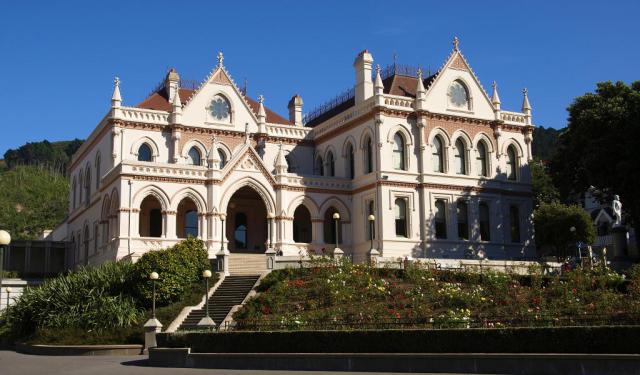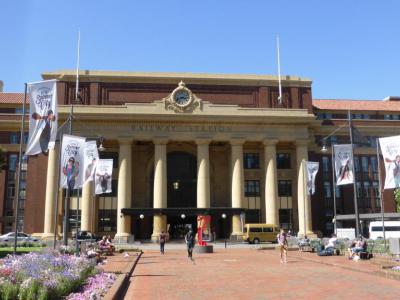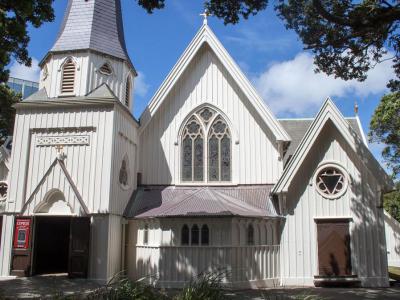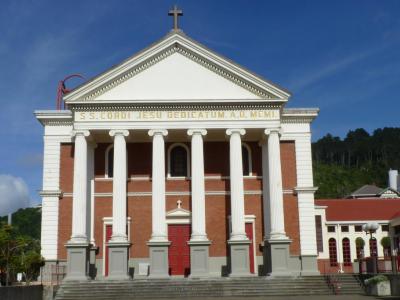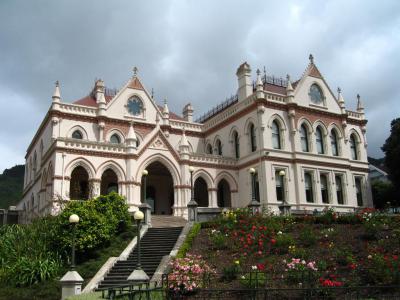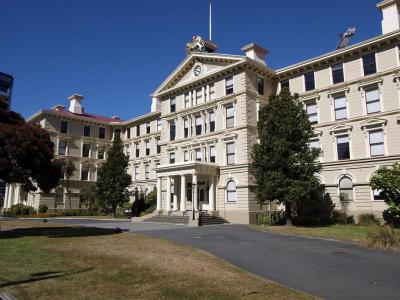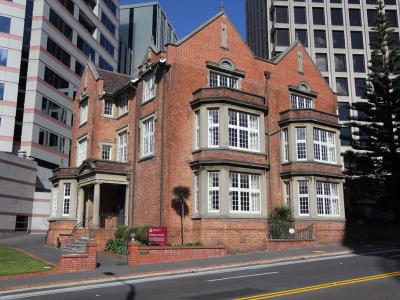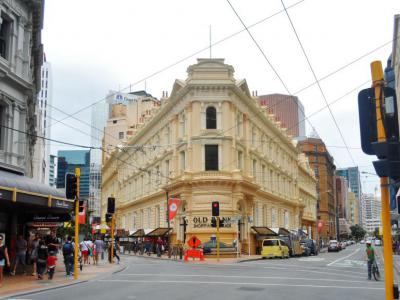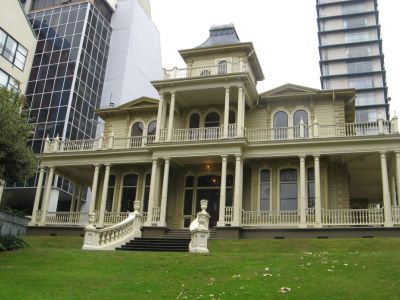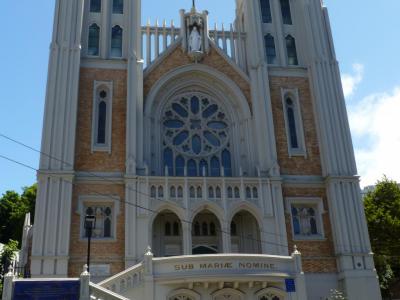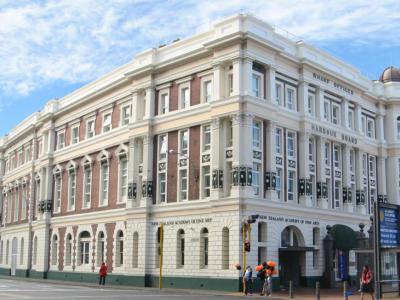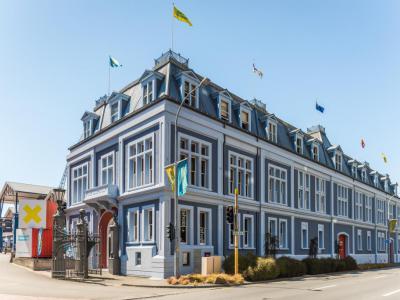Historical Buildings Walking Tour (Self Guided), Wellington
The first immigrants to New Zealand brought along their sense of style. Most of the country's first settlers, if not all of them, were Britishers; the capital city was no exception. The latter fact is duly reflected in Wellington's historical architecture. These buildings offer a glimpse into the city's past and add a great deal of charm to the cityscape. Let's take a quick look at some of these notable landmarks.
Wellington Railway Station: This iconic transportation hub is a symbol of Wellington's development, welcoming travelers from all corners of New Zealand.
The stunning wooden Old Saint Paul's church, not far off, dates back to the mid-19th century. It showcases the Gothic Revival style and is a historical and cultural gem in the true sense of the word.
A magnificent example of Palladian architecture, the Sacred Heart Cathedral is not only a place of worship but also a testament to the city's spiritual heritage.
Nestled within the parliamentary precinct, the elegant building of the New Zealand Parliamentary Library houses a vast collection of knowledge and history, making it an essential part of Wellington's cultural landscape.
The Old Government Buildings represent the largest wooden structure in the Southern Hemisphere. This neoclassical edifice is a testament to Wellington's colonial history.
Turnbull House: This historic mansion, once a family home, today reminds us of Wellington's yesteryear. Its Victorian architecture stands out amid modern surroundings.
A testament to the city's commercial history, the Old Bank Shopping Arcade is a major shopping destination, blending the old with the new.
More than just relics of the past, these and other architectural gems of Wellington are the living symbols of its culture. We encourage everyone to take this self-guided tour and discover the stories these buildings have to tell, as they continue shaping the city's identity and future.
Wellington Railway Station: This iconic transportation hub is a symbol of Wellington's development, welcoming travelers from all corners of New Zealand.
The stunning wooden Old Saint Paul's church, not far off, dates back to the mid-19th century. It showcases the Gothic Revival style and is a historical and cultural gem in the true sense of the word.
A magnificent example of Palladian architecture, the Sacred Heart Cathedral is not only a place of worship but also a testament to the city's spiritual heritage.
Nestled within the parliamentary precinct, the elegant building of the New Zealand Parliamentary Library houses a vast collection of knowledge and history, making it an essential part of Wellington's cultural landscape.
The Old Government Buildings represent the largest wooden structure in the Southern Hemisphere. This neoclassical edifice is a testament to Wellington's colonial history.
Turnbull House: This historic mansion, once a family home, today reminds us of Wellington's yesteryear. Its Victorian architecture stands out amid modern surroundings.
A testament to the city's commercial history, the Old Bank Shopping Arcade is a major shopping destination, blending the old with the new.
More than just relics of the past, these and other architectural gems of Wellington are the living symbols of its culture. We encourage everyone to take this self-guided tour and discover the stories these buildings have to tell, as they continue shaping the city's identity and future.
How it works: Download the app "GPSmyCity: Walks in 1K+ Cities" from Apple App Store or Google Play Store to your mobile phone or tablet. The app turns your mobile device into a personal tour guide and its built-in GPS navigation functions guide you from one tour stop to next. The app works offline, so no data plan is needed when traveling abroad.
Historical Buildings Walking Tour Map
Guide Name: Historical Buildings Walking Tour
Guide Location: New Zealand » Wellington (See other walking tours in Wellington)
Guide Type: Self-guided Walking Tour (Sightseeing)
# of Attractions: 11
Tour Duration: 2 Hour(s)
Travel Distance: 3.5 Km or 2.2 Miles
Author: vickyc
Sight(s) Featured in This Guide:
Guide Location: New Zealand » Wellington (See other walking tours in Wellington)
Guide Type: Self-guided Walking Tour (Sightseeing)
# of Attractions: 11
Tour Duration: 2 Hour(s)
Travel Distance: 3.5 Km or 2.2 Miles
Author: vickyc
Sight(s) Featured in This Guide:
- Wellington Railway Station
- Old St. Paul's
- Sacred Heart Cathedral
- New Zealand Parliamentary Library
- Old Government Buildings
- Turnbull House
- Old Bank Shopping Arcade
- Antrim House
- St. Mary of the Angels
- Academy of Fine Arts
- Wellington Museum, Bond Store Building
1) Wellington Railway Station
Wellington Railway Station is a significant landmark and transport hub in Wellington, serving as the primary railway station for the city. It functions as the southern terminus for several key rail lines, including the North Island Main Trunk, Wairarapa Line, and Johnsonville Line. The station, which opened its doors in June 1937, was established to consolidate the operations of Wellington's previous two termini, Lambton and Thorndon, into one central location.
Beyond its role in transportation, Wellington Railway Station holds a place of historical and cultural importance, underscored by its registration as a Category I Historic Place on 25 September 1986. This designation reflects its architectural, historical, and social value to the nation.
A poignant feature within the station is a roll of honour located in the office entrance, commemorating 450 members of the New Zealand Railways Department who lost their lives during World War I. This memorial, unveiled by Prime Minister William Massey in 1922, stands as a tribute to the sacrifices made by the department's employees, a significant portion of whom enlisted during the war. Originally housed in the Railways Department's head office, the memorial was relocated to the railway station following its opening in 1937.
Wellington Railway Station has appeared in popular culture, notably in the 1981 film "Goodbye Pork Pie" and in various advertisements, such as a 2009 TV advert for TheTrainLine in the UK and a 2014 commercial with Nigella Lawson promoting Whittaker's chocolate.
The station’s inclusion in various media and its historical significance underscore its integral role in Wellington’s social and cultural landscape, serving not only as a vital transport hub but also as a site of remembrance and representation in the broader New Zealand narrative.
Beyond its role in transportation, Wellington Railway Station holds a place of historical and cultural importance, underscored by its registration as a Category I Historic Place on 25 September 1986. This designation reflects its architectural, historical, and social value to the nation.
A poignant feature within the station is a roll of honour located in the office entrance, commemorating 450 members of the New Zealand Railways Department who lost their lives during World War I. This memorial, unveiled by Prime Minister William Massey in 1922, stands as a tribute to the sacrifices made by the department's employees, a significant portion of whom enlisted during the war. Originally housed in the Railways Department's head office, the memorial was relocated to the railway station following its opening in 1937.
Wellington Railway Station has appeared in popular culture, notably in the 1981 film "Goodbye Pork Pie" and in various advertisements, such as a 2009 TV advert for TheTrainLine in the UK and a 2014 commercial with Nigella Lawson promoting Whittaker's chocolate.
The station’s inclusion in various media and its historical significance underscore its integral role in Wellington’s social and cultural landscape, serving not only as a vital transport hub but also as a site of remembrance and representation in the broader New Zealand narrative.
2) Old St. Paul's (must see)
Old Saint Paul's is an Anglican church. The church was completed in 1866 in the Gothic Revival architectural style. The architect was Reverend Frederick Thatcher, the vicar of Saint Paul's in Thorndon.
A south transept, designed by Christian Julius Toxward, was added in 1868 to protect the church from high winds. He also designed a north transept and an extension of the north aisle in 1874 and a choir vestry in 1882.
The Diocese moved to the new Saint Paul's Cathedral in 1964. The New Zealand Government purchased Old Saint Paul's in 1967 and restored it in order to avoid demolition.
The church now displays flags in the nave that represent the Royal Navy, the New Zealand Merchant Navy and the United States Marine Corps. The interior of Old Saint Paul's has memorial plaques, specifically for those who died in World War I.
The church is now a historical site and an event venue managed by Heritage New Zealand Pouhere Taonga.
A south transept, designed by Christian Julius Toxward, was added in 1868 to protect the church from high winds. He also designed a north transept and an extension of the north aisle in 1874 and a choir vestry in 1882.
The Diocese moved to the new Saint Paul's Cathedral in 1964. The New Zealand Government purchased Old Saint Paul's in 1967 and restored it in order to avoid demolition.
The church now displays flags in the nave that represent the Royal Navy, the New Zealand Merchant Navy and the United States Marine Corps. The interior of Old Saint Paul's has memorial plaques, specifically for those who died in World War I.
The church is now a historical site and an event venue managed by Heritage New Zealand Pouhere Taonga.
3) Sacred Heart Cathedral
The Sacred Heart Cathedral, also known as the Metropolitan Cathedral of the Sacred Heart and of Saint Mary His Mother, is a significant Roman Catholic place of worship. Initially, the site housed Saint Mary's Cathedral, which was constructed and blessed in 1851. Unfortunately, in 1898, during renovation work, a fire devastated the building. As the Catholic community in Wellington primarily resided in the Te Aro and Newtown areas, it was decided to construct a new cathedral in that vicinity and to build a functional brick church on the grounds of the former cathedral.
However, the resulting new church, named the Basilica of the Sacred Heart, turned out to be more elaborate than intended. Its construction began in 1899, and it was inaugurated two years later. The funds allocated for the new cathedral were redirected to build the Sacred Heart Basilica instead, and consequently, the intended cathedral was never realized. Subsequently, in 1983, the Basilica was designated as a cathedral by Cardinal Thomas Williams.
The Sacred Heart Cathedral boasts a rich musical heritage, with two instrumental and vocal ensembles leading hymn-singing during Sunday Mass. Additionally, a boys' choir, comprising approximately 15 boys from the nearby Sacred Heart Cathedral School, received scholarships covering vocal and theory lessons. They occasionally performed Choral Masses during the school term.
The Cathedral houses the Grand Organ in the choir loft, with the console located in the whispering gallery. Originally designed and constructed by Arthur Hobday in 1905, the organ has undergone revisions and expansions over the years to meet the cathedral's evolving needs.
Within the Cathedral, visitors can find small statues of the Four Evangelists at the entrance, which were originally positioned under the first High Altar. Near the sanctuary stands a statue of Saint Brigid, the patron of Saint Brigid's Church in Wadestown, which closed in 2007. In the sanctuary, there is a Processional Cross by Graham Stewart made for Pope John Paul II's 1986 visit. Notable mosaics decorate the area, and beneath the Stations of the Cross are fourteen bronzes titled Mater Dolorosa, crafted by sculptor Eve Black, showing Mary's anguish during her son's journey.
However, the resulting new church, named the Basilica of the Sacred Heart, turned out to be more elaborate than intended. Its construction began in 1899, and it was inaugurated two years later. The funds allocated for the new cathedral were redirected to build the Sacred Heart Basilica instead, and consequently, the intended cathedral was never realized. Subsequently, in 1983, the Basilica was designated as a cathedral by Cardinal Thomas Williams.
The Sacred Heart Cathedral boasts a rich musical heritage, with two instrumental and vocal ensembles leading hymn-singing during Sunday Mass. Additionally, a boys' choir, comprising approximately 15 boys from the nearby Sacred Heart Cathedral School, received scholarships covering vocal and theory lessons. They occasionally performed Choral Masses during the school term.
The Cathedral houses the Grand Organ in the choir loft, with the console located in the whispering gallery. Originally designed and constructed by Arthur Hobday in 1905, the organ has undergone revisions and expansions over the years to meet the cathedral's evolving needs.
Within the Cathedral, visitors can find small statues of the Four Evangelists at the entrance, which were originally positioned under the first High Altar. Near the sanctuary stands a statue of Saint Brigid, the patron of Saint Brigid's Church in Wadestown, which closed in 2007. In the sanctuary, there is a Processional Cross by Graham Stewart made for Pope John Paul II's 1986 visit. Notable mosaics decorate the area, and beneath the Stations of the Cross are fourteen bronzes titled Mater Dolorosa, crafted by sculptor Eve Black, showing Mary's anguish during her son's journey.
4) New Zealand Parliamentary Library
The New Zealand Parliamentary Library, formerly known as the General Assembly Library until 1985, serves as the primary library and information hub for the New Zealand Parliament. Its current premises were completed in 1899.
Initially, the General Assembly Library was housed in a modest room shared with the Auckland Provincial Council, containing a mere 750 volumes in 1860. Subsequently, it relocated to a cottage behind the main Parliament building, where its collection expanded to 4000 books. However, during Parliament's move to Wellington in 1862, a ship carrying some of its books, the White Swan, met with disaster on the Wairarapa coast, resulting in the loss of many valuable documents and reference materials.
The mishap of the White Swan was often cited as the reason for the failure to produce certain documents deemed sensitive. Despite setbacks, the library continued to grow, eventually occupying six spacious rooms behind Parliament in Wellington. Cataloguing efforts began with an author catalogue in 1867, followed by a classified catalogue in 1872. By 1897, the library boasted nearly 40,000 volumes, making it a vital repository of knowledge and a source of international ideas, philosophy, and literature for parliamentarians and staff alike.
Alfred Domett, New Zealand's Premier and a poet, advocated for limited access to non-parliamentarians, a privilege that faced opposition at times. Notably, writer Katherine Mansfield enjoyed borrowing privileges during parliamentary recesses, accessing works by various authors including Heinrich Heine, Nietzsche, and translations of Bushido by Dr. Inazo Nitobe.
The current library building in Wellington, now occupied by the Parliamentary Library, was originally constructed for the General Assembly Library in 1899. Designed by Thomas Turnbull in the Gothic Revival style, it was built to withstand fire, utilizing brick made at Mount Cook gaol and featuring an iron firedoor that protected the library during the 1907 fire which ravaged the wooden parliament buildings.
Recognized as a Category I heritage structure by the New Zealand Historic Places Trust, it stands as the oldest surviving building within the Parliament complex.
Initially, the General Assembly Library was housed in a modest room shared with the Auckland Provincial Council, containing a mere 750 volumes in 1860. Subsequently, it relocated to a cottage behind the main Parliament building, where its collection expanded to 4000 books. However, during Parliament's move to Wellington in 1862, a ship carrying some of its books, the White Swan, met with disaster on the Wairarapa coast, resulting in the loss of many valuable documents and reference materials.
The mishap of the White Swan was often cited as the reason for the failure to produce certain documents deemed sensitive. Despite setbacks, the library continued to grow, eventually occupying six spacious rooms behind Parliament in Wellington. Cataloguing efforts began with an author catalogue in 1867, followed by a classified catalogue in 1872. By 1897, the library boasted nearly 40,000 volumes, making it a vital repository of knowledge and a source of international ideas, philosophy, and literature for parliamentarians and staff alike.
Alfred Domett, New Zealand's Premier and a poet, advocated for limited access to non-parliamentarians, a privilege that faced opposition at times. Notably, writer Katherine Mansfield enjoyed borrowing privileges during parliamentary recesses, accessing works by various authors including Heinrich Heine, Nietzsche, and translations of Bushido by Dr. Inazo Nitobe.
The current library building in Wellington, now occupied by the Parliamentary Library, was originally constructed for the General Assembly Library in 1899. Designed by Thomas Turnbull in the Gothic Revival style, it was built to withstand fire, utilizing brick made at Mount Cook gaol and featuring an iron firedoor that protected the library during the 1907 fire which ravaged the wooden parliament buildings.
Recognized as a Category I heritage structure by the New Zealand Historic Places Trust, it stands as the oldest surviving building within the Parliament complex.
5) Old Government Buildings
The Government Buildings Historic Reserve, also known as Old Government Buildings, dates back to 1876. Notably, it holds the title of being the largest wooden structure in the Southern Hemisphere and the second-largest globally. Initially erected to accommodate New Zealand's public service, it currently serves as the home of the Victoria University of Wellington's Law School. Classified as a "Category I" historic site, it bears significant cultural and heritage value.
Commissioned during the early 1870s by the Fox Ministry, the construction was prompted partly by the impending dissolution of provincial governments. Originally intended to incorporate both concrete and timber, budget constraints led to a decision to opt solely for timber construction. Despite its design mimicking the Italianate Neo-Renaissance style typically associated with stone buildings, the choice of timber was driven by cost considerations.
Symbolizing national strength and stability, the building was crafted to emulate an Italian stone palace, underscoring its importance within the expanding empire. Constructed from native kauri timber, its unique material cannot be replicated today due to conservation measures protecting New Zealand's remaining kauri forests. Had it been built with stone as initially planned, its survival through subsequent earthquakes, given its proximity to a major fault line, might have been questionable. The architectural design was overseen by William Clayton.
Boasting an impressive 143 rooms, 64 toilets, 126 fireplaces, and 22 chimneys, the building was a monumental feat upon its completion after 22 months of construction. It stood as the country's largest structure and is now revered as one of New Zealand's most significant historic landmarks.
Following its formal reopening in January 1996, the Law Faculty of Victoria University assumed a 50-year tenancy, becoming the building's new occupants. Its restoration is hailed as a pivotal government-led initiative in heritage conservation. While the grounds are accessible to the public, featuring rare native New Zealand flora, only certain sections of the building, such as the ground-floor displays and the first-floor Cabinet room, are open for viewing. The remainder of the building is leased to the Victoria University School of Law.
Commissioned during the early 1870s by the Fox Ministry, the construction was prompted partly by the impending dissolution of provincial governments. Originally intended to incorporate both concrete and timber, budget constraints led to a decision to opt solely for timber construction. Despite its design mimicking the Italianate Neo-Renaissance style typically associated with stone buildings, the choice of timber was driven by cost considerations.
Symbolizing national strength and stability, the building was crafted to emulate an Italian stone palace, underscoring its importance within the expanding empire. Constructed from native kauri timber, its unique material cannot be replicated today due to conservation measures protecting New Zealand's remaining kauri forests. Had it been built with stone as initially planned, its survival through subsequent earthquakes, given its proximity to a major fault line, might have been questionable. The architectural design was overseen by William Clayton.
Boasting an impressive 143 rooms, 64 toilets, 126 fireplaces, and 22 chimneys, the building was a monumental feat upon its completion after 22 months of construction. It stood as the country's largest structure and is now revered as one of New Zealand's most significant historic landmarks.
Following its formal reopening in January 1996, the Law Faculty of Victoria University assumed a 50-year tenancy, becoming the building's new occupants. Its restoration is hailed as a pivotal government-led initiative in heritage conservation. While the grounds are accessible to the public, featuring rare native New Zealand flora, only certain sections of the building, such as the ground-floor displays and the first-floor Cabinet room, are open for viewing. The remainder of the building is leased to the Victoria University School of Law.
6) Turnbull House
Turnbull House, located in Wellington, holds significant historical value. Constructed in 1915 as the residence of Alexander Turnbull, a notable figure in New Zealand known for his business ventures, refined taste, and passion for collecting books. Turnbull's personal library, now known as the Alexander Turnbull Library, was housed here and later bequeathed to New Zealand. Recognized by Heritage New Zealand as a top-tier historic site, Turnbull House stands adjacent to The Beehive amidst New Zealand's Parliamentary Precinct.
The Alexander Turnbull Library, entrusted to the National Library, preserves and provides access to its vast collection, emphasizing its importance to New Zealand's cultural heritage. Turnbull's meticulous collection notably includes extensive works by John Milton, acclaimed globally. The architectural style of Turnbull House blends elements of Queen Anne and Scottish baronial designs, conceived by architect William Turnbull. The house originally boasted three spacious library rooms to accommodate Turnbull's extensive collection of literary treasures.
However, the outbreak of World War I delayed its completion until late 1915. Following Turnbull's passing in 1918, the government acquired the house in 1920, transforming it into the Alexander Turnbull Library, which remained until 1973. Subsequently, the collection merged with the National Library of New Zealand.
In recent years, Turnbull House served as a venue for various gatherings until concerns over earthquake safety prompted its closure to the public in 2012. Despite delays in investigations, efforts to reinforce the structure are underway, with completion targeted before the 2023 deadline.
The Alexander Turnbull Library, entrusted to the National Library, preserves and provides access to its vast collection, emphasizing its importance to New Zealand's cultural heritage. Turnbull's meticulous collection notably includes extensive works by John Milton, acclaimed globally. The architectural style of Turnbull House blends elements of Queen Anne and Scottish baronial designs, conceived by architect William Turnbull. The house originally boasted three spacious library rooms to accommodate Turnbull's extensive collection of literary treasures.
However, the outbreak of World War I delayed its completion until late 1915. Following Turnbull's passing in 1918, the government acquired the house in 1920, transforming it into the Alexander Turnbull Library, which remained until 1973. Subsequently, the collection merged with the National Library of New Zealand.
In recent years, Turnbull House served as a venue for various gatherings until concerns over earthquake safety prompted its closure to the public in 2012. Despite delays in investigations, efforts to reinforce the structure are underway, with completion targeted before the 2023 deadline.
7) Old Bank Shopping Arcade
The Old Bank Shopping Arcade is situated within a structure formerly occupied by the Bank of New Zealand. This property encompasses four buildings constructed between 1883 and 1904, with the primary one being the Bank of New Zealand building, positioned at the wedge-shaped intersection of Lambton Quay and Customhouse Quay. Designed by Thomas Turnbull for the Bank of New Zealand, it stands on the former site of Plimmer's Ark. Constructed by T. Carmichael, the building is characterized by its brickwork exterior, timber flooring, pressed metal ceilings, and plaster adornments. The Bank of New Zealand operated a branch on the ground floor of this building from its inauguration in 1901 until 1984.
The banking hall, described as "a handsome, lofty room, said to be one of the largest of its kind in the colonies" by the New Zealand Mail in 1901, holds historical significance. This building has been recognized as a "Category I" historic place by the New Zealand Historic Places Trust, denoting its special or outstanding historical or cultural heritage significance.
Established in 1999, the shopping arcade boasts a collection of exclusive boutiques, many of which are owned by local New Zealand designers. Visitors can also admire an animated clock narrating the historical tale of Plimmer's Ark, alongside enjoying various cafes and restaurants within the premises.
The banking hall, described as "a handsome, lofty room, said to be one of the largest of its kind in the colonies" by the New Zealand Mail in 1901, holds historical significance. This building has been recognized as a "Category I" historic place by the New Zealand Historic Places Trust, denoting its special or outstanding historical or cultural heritage significance.
Established in 1999, the shopping arcade boasts a collection of exclusive boutiques, many of which are owned by local New Zealand designers. Visitors can also admire an animated clock narrating the historical tale of Plimmer's Ark, alongside enjoying various cafes and restaurants within the premises.
8) Antrim House
Antrim House, completed in 1905 for Robert Hannah (1845–1930) and his wife Hannah Hannah (1852–1928), stands as a significant architectural landmark. Robert Hannah, an Irish immigrant from County Antrim, commissioned its construction. Designated as a "Category I" historic site by the New Zealand Historic Places Trust, the building reflects the prevailing architectural tastes of its time, notably the Queen Anne and Second Empire styles. This is evident in its ornate interior cornices, the original iron detailing (now lost), and the central tower.
Constructed primarily from kauri and heart totara, with concrete foundations, Antrim House served as a testament to Robert Hannah's success and status. Situated prominently, it showcased his taste and affluence. The landscaped garden in front of the house complemented its features, adding to its appeal.
Inside, Antrim House boasted modern amenities such as gas piping, electric lights, and a piped bathroom. Its pressed-zinc ceilings, stained glass lead lighting, and turned features exemplified contemporary elegance and sophistication.
However, following the departure of the Hannah family in the 1930s, Antrim House fell out of favor. Its central location and large size became drawbacks, leading to its conversion into a boarding house, a fate shared by many urban mansions of its era. Tragically, a fire in 1940 caused significant damage, resulting in the loss of original features.
Despite efforts at reconstruction, some of the house's unique elements, such as the asymmetrical windows atop the tower and the Art Deco styled arch above the formal stair, were not faithfully restored. This marked a loss of its original architectural integrity.
Constructed primarily from kauri and heart totara, with concrete foundations, Antrim House served as a testament to Robert Hannah's success and status. Situated prominently, it showcased his taste and affluence. The landscaped garden in front of the house complemented its features, adding to its appeal.
Inside, Antrim House boasted modern amenities such as gas piping, electric lights, and a piped bathroom. Its pressed-zinc ceilings, stained glass lead lighting, and turned features exemplified contemporary elegance and sophistication.
However, following the departure of the Hannah family in the 1930s, Antrim House fell out of favor. Its central location and large size became drawbacks, leading to its conversion into a boarding house, a fate shared by many urban mansions of its era. Tragically, a fire in 1940 caused significant damage, resulting in the loss of original features.
Despite efforts at reconstruction, some of the house's unique elements, such as the asymmetrical windows atop the tower and the Art Deco styled arch above the formal stair, were not faithfully restored. This marked a loss of its original architectural integrity.
9) St. Mary of the Angels
Saint Mary of the Angels in Wellington started as a small chapel in 1843, built by Father O'Riley and made official by Bishop Pompallier in 1844. Over time, it went through many changes to become the striking building it is now. The first chapel, called "the chapel of the Nativity," was expanded several times until a bigger wooden church named "Saint Mary of the Angels" replaced it in 1874, in honor of a chapel important to Saint Francis of Assisi. This building was destroyed by fire in 1918, leading to the construction of the current building, which opened in 1922 with a blessing from Archbishop Redwood.
Frederick de Jersey Clere designed the church in 1919, incorporating traditional Gothic styles with some French influence. Its front design, inspired by the Cathedral of Saint Michael and Saint Gudula in Brussels, was groundbreaking for using reinforced concrete in a Gothic church, a mix of concrete, brick, and a timber roof supported by concrete arches and steel rods, ensuring it was both stunning and sturdy.
Inside, the church has beautiful stained glass windows around the upper walls, including a special rose window and others that show scenes from the crucifixion, the Rosary, and Saint Joseph's life. These windows create a colorful, sacred feel inside. The church is also filled with statues, like a marble version of Michelangelo's Moses, the Pietà, the Holy Family, and various saints, adding to its spiritual atmosphere.
The church has a strong tradition of liturgical music, starting with Gregorian Chant in 1905. When the current building was opened in 1922, a choir of 70, directed by Edward Healy, sang at the first Mass. Its organ, built in 1958 by George Croft and Son Limited and updated in 1984, showcases the church's commitment to music.
Saint Mary of the Angels is also a historical site, recognized as a "Category I" historic place for its significant history, architectural beauty, and cultural importance. It's been a vital part of Wellington's Catholic community, from being Archbishop O'Shea's pro-cathedral between 1936 and 1954 to hosting Suzanne Aubert's funeral in 1926, known for its church music and spiritual support to the community.
Frederick de Jersey Clere designed the church in 1919, incorporating traditional Gothic styles with some French influence. Its front design, inspired by the Cathedral of Saint Michael and Saint Gudula in Brussels, was groundbreaking for using reinforced concrete in a Gothic church, a mix of concrete, brick, and a timber roof supported by concrete arches and steel rods, ensuring it was both stunning and sturdy.
Inside, the church has beautiful stained glass windows around the upper walls, including a special rose window and others that show scenes from the crucifixion, the Rosary, and Saint Joseph's life. These windows create a colorful, sacred feel inside. The church is also filled with statues, like a marble version of Michelangelo's Moses, the Pietà, the Holy Family, and various saints, adding to its spiritual atmosphere.
The church has a strong tradition of liturgical music, starting with Gregorian Chant in 1905. When the current building was opened in 1922, a choir of 70, directed by Edward Healy, sang at the first Mass. Its organ, built in 1958 by George Croft and Son Limited and updated in 1984, showcases the church's commitment to music.
Saint Mary of the Angels is also a historical site, recognized as a "Category I" historic place for its significant history, architectural beauty, and cultural importance. It's been a vital part of Wellington's Catholic community, from being Archbishop O'Shea's pro-cathedral between 1936 and 1954 to hosting Suzanne Aubert's funeral in 1926, known for its church music and spiritual support to the community.
10) Academy of Fine Arts
The Academy of Fine Arts is situated in a historical edifice known as the Wellington Harbour Board Wharf Office Building, also recognized as Shed 7. Situated on Jervois Quay, it was constructed by the Wellington Harbour Board. This building holds significant historical and cultural value and is categorized as a "Category 1" historic place by Heritage New Zealand. Presently, it accommodates the New Zealand Academy of Fine Arts and 25 upscale urban apartments.
Formerly, the Academy's premises on Whitmore Street housed both the national art collection and the Academy's permanent collection. However, during the transition to the new National Art Gallery, all of the Academy's artwork was amalgamated into the national collection, a move that faced some opposition.
The New Zealand Academy of Fine Arts, also known as the Wellington Art Society, originated in Wellington in July 1882 under the name The Fine Arts Association of New Zealand. Notable founding artists included William Beetham and Charles Decimus Barraud. The association later changed its name to the New Zealand Academy of Fine Arts in 1889. Traditionally, the Governor-General of New Zealand serves as the patron of the Academy.
The primary objective of the Academy of Fine Arts is to foster the development of fine arts in New Zealand and conserve works of art by local artists. Throughout the year, it hosts various exhibitions showcasing outstanding New Zealand artists. Some notable artists who have displayed their work at the Academy include Gottfried Lindauer, Frances Hodgkins, Charles Goldie, Rita Angus, Ralph Hotere, and John Drawbridge.
Formerly, the Academy's premises on Whitmore Street housed both the national art collection and the Academy's permanent collection. However, during the transition to the new National Art Gallery, all of the Academy's artwork was amalgamated into the national collection, a move that faced some opposition.
The New Zealand Academy of Fine Arts, also known as the Wellington Art Society, originated in Wellington in July 1882 under the name The Fine Arts Association of New Zealand. Notable founding artists included William Beetham and Charles Decimus Barraud. The association later changed its name to the New Zealand Academy of Fine Arts in 1889. Traditionally, the Governor-General of New Zealand serves as the patron of the Academy.
The primary objective of the Academy of Fine Arts is to foster the development of fine arts in New Zealand and conserve works of art by local artists. Throughout the year, it hosts various exhibitions showcasing outstanding New Zealand artists. Some notable artists who have displayed their work at the Academy include Gottfried Lindauer, Frances Hodgkins, Charles Goldie, Rita Angus, Ralph Hotere, and John Drawbridge.
11) Wellington Museum, Bond Store Building
Wellington Museum is situated within the historic Bond Store building along Jervois Quay on the scenic waterfront of Wellington Harbour. Commissioned in 1890 by the Wellington Harbour Board, the Bond Store replaced older wooden structures from the 1860s. The building, designed by Frederick de Jersey Clere in the elegant French Second Empire style, was completed in 1892, showcasing architectural finesse and historical significance. The Bond Store has been designated a "Category 1" historic place by Heritage New Zealand due to its significant historical or cultural value.
The transformation of this remarkable structure into a museum was finalized in 1999, marking a new chapter in its storied existence. Initially established in 1972 as the Wellington Maritime Museum by the Wellington Harbour Board, the institution was handed over to the Wellington City Council in 1989. This transition not only expanded its scope to encompass the social history of the Wellington region but also continued to celebrate the area's significant maritime past. To this day, an entire floor is devoted to maritime history and culture, reflecting Wellington's deep connection with the sea.
Wellington Museum spans four floors, each narrating different facets of Wellington's history-from its maritime roots and the early interactions between Māori and European settlers, to the region's development over the 150 years since Wellington became the capital of New Zealand. The museum's dynamic exhibitions and interactive displays, including a giant cinema screen that spans the ground to the second floor, bring to life the stories and evolution of the city.
The museum features three distinct theatre areas. One utilizes a pepper's ghost to recount Māori legends, another serves as a memorial to the tragic sinking of the Wahine ferry in Wellington Harbour, and the third, known as the Wellington Time Machine, offers a unique journey through the city's past, located on the top floor. In late 2015, a new exhibition space named The Attic was unveiled following extensive refurbishment and restoration, adding another dimension to the museum's rich offering.
The transformation of this remarkable structure into a museum was finalized in 1999, marking a new chapter in its storied existence. Initially established in 1972 as the Wellington Maritime Museum by the Wellington Harbour Board, the institution was handed over to the Wellington City Council in 1989. This transition not only expanded its scope to encompass the social history of the Wellington region but also continued to celebrate the area's significant maritime past. To this day, an entire floor is devoted to maritime history and culture, reflecting Wellington's deep connection with the sea.
Wellington Museum spans four floors, each narrating different facets of Wellington's history-from its maritime roots and the early interactions between Māori and European settlers, to the region's development over the 150 years since Wellington became the capital of New Zealand. The museum's dynamic exhibitions and interactive displays, including a giant cinema screen that spans the ground to the second floor, bring to life the stories and evolution of the city.
The museum features three distinct theatre areas. One utilizes a pepper's ghost to recount Māori legends, another serves as a memorial to the tragic sinking of the Wahine ferry in Wellington Harbour, and the third, known as the Wellington Time Machine, offers a unique journey through the city's past, located on the top floor. In late 2015, a new exhibition space named The Attic was unveiled following extensive refurbishment and restoration, adding another dimension to the museum's rich offering.
Walking Tours in Wellington, New Zealand
Create Your Own Walk in Wellington
Creating your own self-guided walk in Wellington is easy and fun. Choose the city attractions that you want to see and a walk route map will be created just for you. You can even set your hotel as the start point of the walk.
Wellington Introduction Walking Tour
Wellington is the capital of New Zealand and the country's second-largest city after Auckland. It also has the distinction of being the world's windiest city by average wind speed.
The city was designed by Captain William Mein Smith in 1840. He was the first Surveyor General for Edward Wakefield's New Zealand Company. The name comes from Arthur Wellesley, the first Duke of... view more
Tour Duration: 2 Hour(s)
Travel Distance: 3.6 Km or 2.2 Miles
The city was designed by Captain William Mein Smith in 1840. He was the first Surveyor General for Edward Wakefield's New Zealand Company. The name comes from Arthur Wellesley, the first Duke of... view more
Tour Duration: 2 Hour(s)
Travel Distance: 3.6 Km or 2.2 Miles
The Most Popular Cities
/ view all
